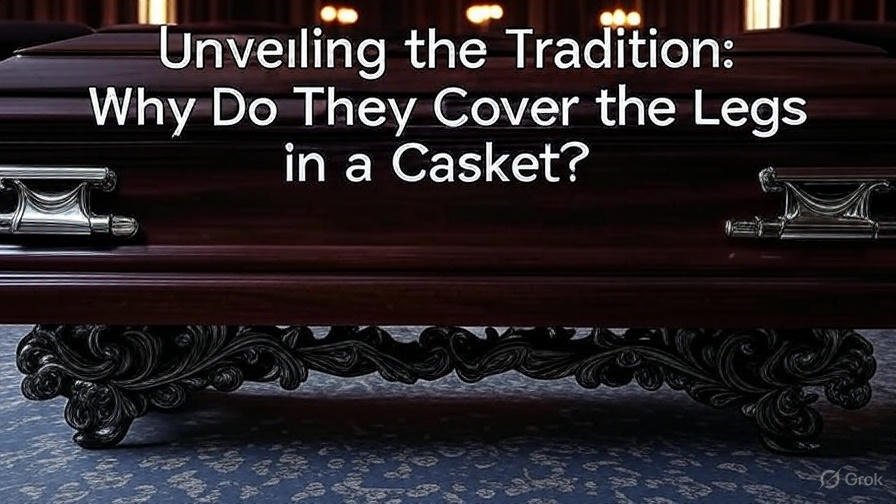Funerals are profound ceremonies, rich with traditions that reflect humanity’s diverse heritage. One practice that often sparks curiosity is the covering of the legs in a casket during viewings and burials. Far from a random choice, this custom carries deep historical and cultural significance, shaped by centuries of evolution. As we examine this tradition in 2025, it reveals a tapestry of respect, practicality, and symbolism that resonates across generations.
This news article uncovers the reasons behind why they cover the legs in a casket, drawing on historical records, cultural insights, and expert perspectives. Whether rooted in Victorian practices or modern funeral aesthetics, this tradition offers a window into how societies honor their departed.
Historical Roots in the Victorian Era
The practice of covering the legs in a casket emerged prominently during the Victorian era (1837–1901), a time when elaborate funeral rituals flourished in Britain and spread to North America. Historical accounts from the British Museum indicate that limited casket space and the use of ornate coffins necessitated focusing on the upper body. Consequently, covering the legs allowed undertakers to present a dignified image, emphasizing the face as the essence of the person’s identity.
Moreover, early embalming techniques, as documented in a 1890s study by the Royal College of Surgeons, were rudimentary, often leaving the lower body less preserved. Therefore, concealing the legs maintained a respectful appearance. This practical solution gradually became a cultural norm, influencing funeral practices into the 20th and 21st centuries.
Cultural and Symbolic Meanings
Beyond logistics, covering the legs in a casket holds profound symbolic value. In Western cultures, it directs attention to the face, believed to house the soul’s essence, according to Christian theology from the Middle Ages. Furthermore, this focus aligns with the tradition of photographing the deceased’s face, a practice common in the 19th century, as noted by the Victoria and Albert Museum.
In contrast, Eastern traditions offer different perspectives. For instance, Hindu funeral rites, as outlined by the Indira Gandhi National Centre for the Arts, involve wrapping the entire body, including the legs, in a shroud for cremation, symbolizing a return to nature. Similarly, in Islamic practices, the body is fully shrouded, reflecting humility and equality before Allah, per guidelines from the Islamic Cultural Centre.
Practical Applications in Modern Funerals
In 2025, the custom persists due to practical considerations. Modern caskets, designed with half-open lids, prioritize the upper body for viewing, a standard endorsed by the National Funeral Directors Association (NFDA). This design saves space and simplifies the process, allowing families to focus on the deceased’s face, often adorned with personal mementos.
Additionally, covering the legs addresses privacy concerns. If a deceased individual experienced leg injuries or swelling—common in cases of prolonged illness—concealment preserves dignity. “This practice ensures the family’s last memory is one of peace,” says Dr. James Hartley, a funeral industry expert with the NFDA, quoted in a 2024 industry report.
Evolving Trends in 2025
As funeral practices evolve, the tradition of covering the legs in a casket is under scrutiny. The rise of eco-friendly burials and personalized ceremonies has led some families to request full-body viewings. However, a 2025 NFDA survey found that 72% of U.S. funerals still feature partial coverage, reflecting its enduring appeal.
Moreover, advancements in embalming, such as those developed by the American Board of Funeral Service Education, have minimized the need to hide imperfections. Yet, many families and funeral directors retain the practice for its familiarity, blending tradition with modern techniques.
Global Variations and Insights
The custom varies globally, reflecting cultural diversity. In Mexico, Día de los Muertos celebrations often feature open caskets with the legs covered by vibrant flowers, as documented by the Mexican Cultural Institute. Conversely, in some African communities, full-body exposure during viewings is preferred, though caskets may still conceal the legs for practicality.
Furthermore, in Japan, Buddhist funerals involve covering the body with a kesa (ritual cloth), including the legs, to signify spiritual transition, according to the Japan Foundation. These variations underscore how the practice adapts to local beliefs while maintaining its core intent of respect.
Debunking Myths and Misconceptions
A common myth suggests that covering the legs in a casket hides a scandalous cause of death. However, this is unfounded, as the practice predates modern forensic awareness and focuses on dignity, not secrecy. Additionally, some assume it reduces costs, but casket prices remain consistent regardless of coverage, per the Federal Trade Commission’s funeral rule.
Therefore, understanding the true purpose can alleviate family anxieties, framing it as a respectful tradition rather than a cover-up.
Conclusion: A Legacy of Reverence
The tradition of covering the legs in a casket is a rich blend of history, culture, and practicality. From its Victorian origins to its adaptation in 2025’s diverse funeral landscapes, it reflects a universal desire to honor the deceased with dignity. Whether driven by symbolic beliefs or logistical needs, this practice connects past and present in a meaningful way.
As societies continue to evolve, the question of why they cover the legs in a casket remains a testament to our shared humanity. Embracing this custom offers families a sense of continuity and respect, ensuring a dignified farewell for generations to come.
You may also read: Mini Goldendoodle Full Grown: Grooming and Care Tips
